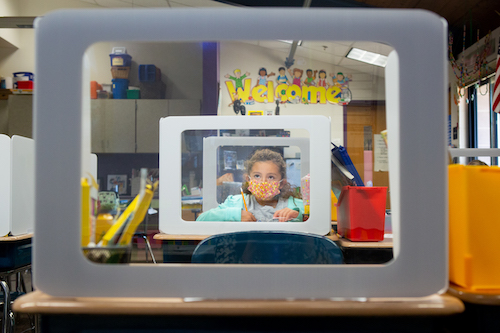The following essay was written by Trina Tocco. She is a resident of Royal Oak and has two amazing children who attend Ferndale Public Schools.
 When the pandemic hit, I had to make a choice – either one of my children wouldn’t be able to participate in virtual school because of mental illness or I would have to put my family at risk by bringing additional caregivers who I didn’t know into my home to help with my children so that I could work. I chose to open my home because the risks of an unsafe home with no one to really turn to didn’t seem like an option.
When the pandemic hit, I had to make a choice – either one of my children wouldn’t be able to participate in virtual school because of mental illness or I would have to put my family at risk by bringing additional caregivers who I didn’t know into my home to help with my children so that I could work. I chose to open my home because the risks of an unsafe home with no one to really turn to didn’t seem like an option.
As a single mom trying to work and homeschool my children, it has often felt like I wouldn’t make it through the day. Emergency services like the Oakland County Mobile Youth Crisis line haven’t been available to go into homes since the start of the pandemic. The pediatric mental health hospitals are at full capacity and families are having to wait weeks in hospital waiting rooms for placements to ensure safety for their children and families. What were gaps in supports and services before the pandemic are now gaping holes.
During this pandemic, families like mine with special needs children have needed an adult from the school to be physically present. Unfortunately, given the lack of school staff, the limitations created by social distancing, and the outdated separation of services that are provided by schools versus community mental health agencies, this just wasn’t possible. Instead, I have had to scramble to find tutors for both of my children.
But even before this crisis, our students in special education were struggling. Years of disinvestment have left our schools, our communities, and our futures dramatically underfunded. Comprehensive research tells us that in Michigan we were already underfunding K-12 schools by at least $3.7 billion annually. For my kids who go to Title I schools in Oakland County, this meant that even though they were reading below grade level, there were other kids that needed the intervention more and thus they had to wait for a spot to open up with a reading interventionist. At my children’s schools, there aren’t enough social workers, paraprofessionals, resource room teachers, or general support for teachers and staff who work so hard everyday.
My family has had services through Easter Seals for years and the burden on these providers is so immense. Even before the pandemic the aides helping out in my home were only getting paid $9 an hour and were expected to manage very complex situations. It’s shameful that so little money is available for our schools and mental health system to ensure adequate support so that families like mine aren’t always in crisis.
The Biden administration’s American Rescue Plan is a great opportunity to make a new start. To ensure this recovery leaves us all with stronger and more equitable schools, Michigan school leaders should spend the federal relief where it is needed most, especially on students of color and those with low incomes, students with disabilities, and English language learners. These are students who not only have been hit hardest by the pandemic but already faced systemic barriers to success. And these are the students we have been underfunding for decades.
In districts, schools, and classrooms, this could look like more one-on-one tutoring even for kids that don’t qualify for special education. This could look like school community partnerships for more social workers and therapists for the kids AND also for their caregivers who often need extensive support as well.
Both of my children receive special education services yet have very different needs and so there should be more funds allocated for children with higher needs so that schools have enough staff to truly support the child and their teachers. This could look like mentoring programs where the mentors are paid for their hard work and support. This could look like feeding children nutritious food instead of the sugary prepackaged foods my kids get from the food service provider at their school.
One of the best ideas I’ve heard comes from an organization called Student Advocacy Center of Michigan. They think schools could use the funds for chill out rooms and creating safe places for kids to go because kids bring all of themselves to school, including hunger and trauma. They need more support to help work through all of that so they can be ready to learn. Finally, we need our schools to use the money to update libraries, train staff and equip themselves with a new perspective on how to create an environment where students to want to learn and connect, including ensuring that students have racial mirrors to help them imagine what is possible for them.
This moment requires bold action. Returning to a status quo that was failing too many of our children is not an option. School districts must make forward-thinking budget decisions, including investing in the most critical, highest impact areas and communities, even when that means raising additional revenues required to maintain those investments going forward. The real opportunity for Michigan in this rescue plan is using this money as a down payment on our future – a new, new deal for Michigan students like my children.
[Student in classroom photo and student on bus photo by Allison Shelley for EDUimages]



